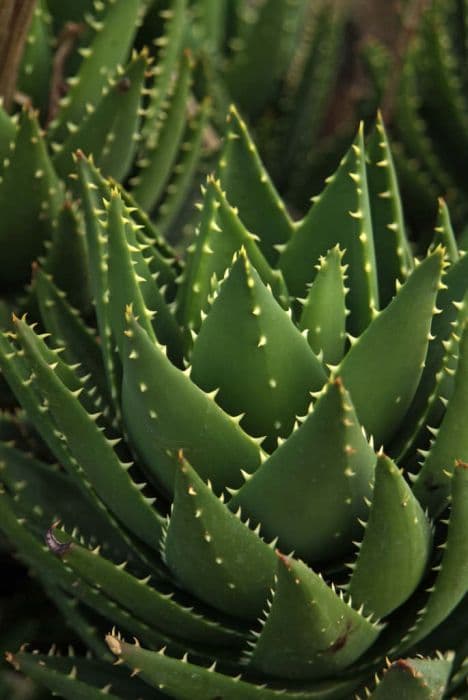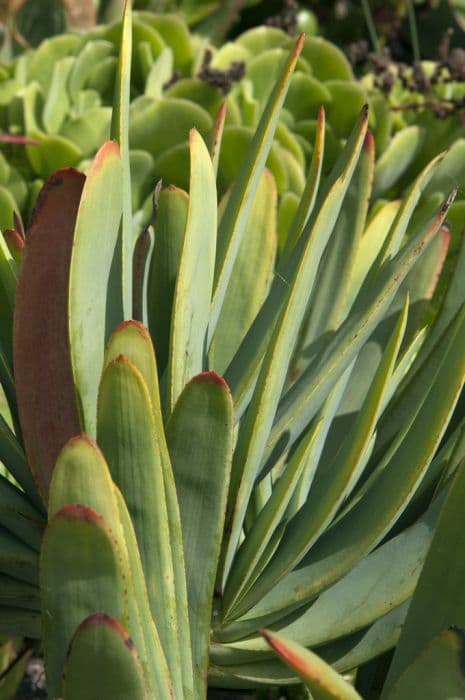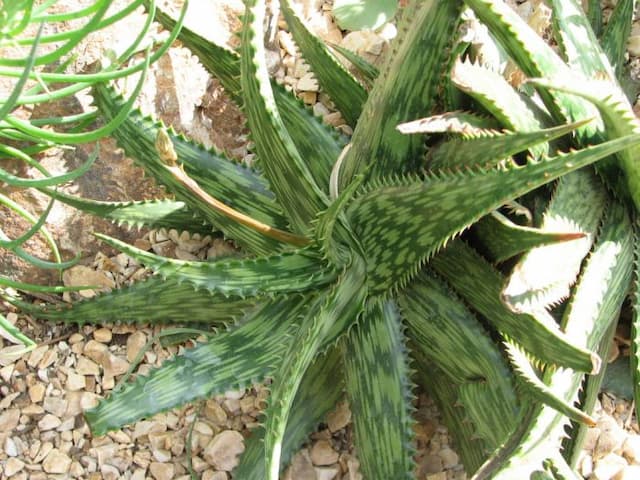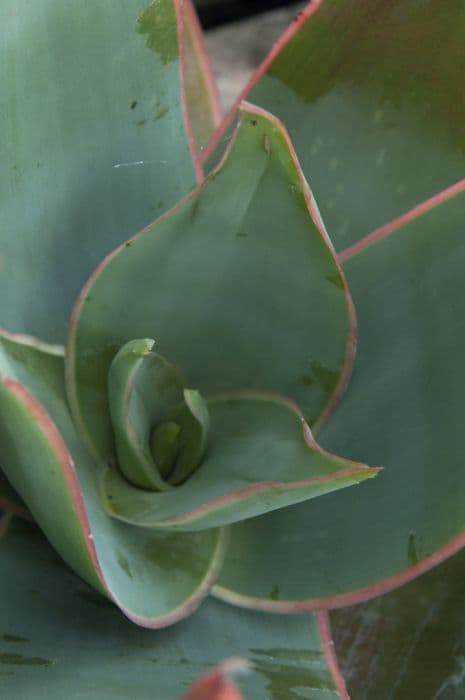Red Hot Poker Kniphofia 'Timothy'

ABOUT
The plant Kniphofia 'Timothy', commonly known as Red Hot Poker, has a distinctive and striking appearance. It features clumps of grass-like, evergreen foliage, which forms a fountain-like base out of which the flower spikes arise. The leaves are typically a rich green color, long, and narrow, resembling the blades of ornamental grass. The most notable characteristic of the Red Hot Poker is its bold flower spikes. These are composed of tubular flowers that are densely arranged around the top of a tall, sturdy, and upright stem. The blooms open from bottom to top over a period of several weeks. The flowers present a fiery display of color, typically ranging from red at the tip, transitioning through shades of orange, and then to a light yellow or cream near the base of the spike, creating a gradient effect reminiscent of a glowing torch or poker. These vibrant flower spikes are a magnet for pollinators, such as bees and hummingbirds, drawn to their bright colors and rich nectar. The Red Hot Poker blooms in the summer months and can provide a long-lasting display of color in the garden. Overall, the Red Hot Poker is a visually captivating plant with its lush, grassy foliage and brilliant, torch-like flower spikes that add vertical interest and a touch of the exotic to any planting scheme.
About this plant
 Names
NamesFamily
Asphodelaceae
Synonyms
Red Hot Poker, Torch Lily, Tritoma
Common names
Kniphofia 'Timothy'.
 Toxicity
ToxicityTo humans
Red hot poker (Kniphofia 'Timothy') is not typically considered to be toxic to humans. However, as with many ornamental plants, it can cause mild stomach upset if ingested. Handling the plant may also cause skin irritation in some individuals due to its physical characteristics, not from toxicity. In general, it's best to avoid eating or handling any part of ornamental plants if you are not sure about its safety. If ingestion occurs and adverse symptoms appear, seek medical attention.
To pets
Red hot poker (Kniphofia 'Timothy') is generally not considered to be toxic to pets. However, as with most ornamental plants, it may cause gastrointestinal discomfort if ingested in large amounts. Symptoms of ingestion might include vomiting, diarrhea, or drooling, which should be monitored by the pet owner. If these symptoms persist or if the pet has consumed a large quantity of the plant, it is advisable to consult a veterinarian.
 Characteristics
CharacteristicsLife cycle
Perennials
Foliage type
Evergreen
Color of leaves
Green
Flower color
Mixed
Height
3-4 feet (0.91-1.22 meters)
Spread
2-3 feet (0.61-0.91 meters)
Plant type
Herb
Hardiness zones
5-9
Native area
South Africa
Benefits
 General Benefits
General Benefits- Attracts pollinators: Kniphofia 'Timothy', commonly known as Red Hot Poker, attracts bees, butterflies, and hummingbirds, which are beneficial for pollination in the garden.
- Drought-tolerant: Once established, it can withstand periods of low water availability, making it suitable for xeriscaping or drought-prone areas.
- Low maintenance: Red Hot Poker is relatively easy to care for, requiring minimal upkeep beyond occasional watering and deadheading.
- Long blooming season: It offers a long flowering period from late spring to early fall, providing vibrant color for an extended time.
- Deer resistant: The plant is not favored by deer, which can help to reduce damage to your garden from these animals.
- Architectural interest: With its bold, spiky flowers and vertical form, it adds architectural interest to landscape designs and garden borders.
- Soil adaptability: It can adapt to a variety of soil conditions, although it prefers well-drained soils.
- Tolerates various climates: Red Hot Poker can thrive in a range of climates from USDA hardiness zones 5 through 9.
 Medical Properties
Medical PropertiesThis plant is not used for medical purposes.
 Air-purifying Qualities
Air-purifying QualitiesThis plant is not specifically known for air purifying qualities.
 Other Uses
Other Uses- Textile Dyeing: The vibrant flowers of Red Hot Poker can be used to produce natural dyes for coloring fabrics.
- Photography: Its striking appearance and bright colors make the Red Hot Poker a popular subject for botanical photography.
- Artistic Inspiration: Artists may use the unique form and color of the Red Hot Poker as inspiration for paintings, drawings, or sculptures.
- Educational Tool: Red Hot Poker can be included in horticultural studies and botanical gardens for educational purposes, illustrating plant ecology and evolution.
- Floral Arrangements: The tall and colorful spikes of Red Hot Poker make them a distinct addition to cut flower arrangements and bouquets.
- Garden Design Theme: They can serve as a focal point in garden designs with a fire or tropical theme, complementing other plants with hot-colored blooms.
- Erosion Control: With their strong root systems, Red Hot Pokers can be planted on slopes or banks to help stabilize soil and prevent erosion.
- Nectar Source for Beekeeping: The flowers provide a rich source of nectar, making them useful in beekeeping areas to support honey production.
- Marker Plant: Due to their height and visibility, Red Hot Pokers can be used as marker plants to delineate spaces or as visual guides in large gardens or parks.
- Seasonal Festivities: The bright, torch-like appearance of their blooms allows them to be incorporated into garden displays for seasonal celebrations such as summer solstice events.
Interesting Facts
 Feng Shui
Feng ShuiThe Red Hot Poker is not used in Feng Shui practice.
 Zodiac Sign Compitability
Zodiac Sign CompitabilityThe Red Hot Poker is not used in astrology practice.
 Plant Symbolism
Plant Symbolism- Attraction and Beauty: The vibrant, attention-grabbing colors of the Red Hot Poker flower symbolize attraction and beauty, making them a striking presence in any garden or as a visual metaphor.
- Standing Out: Because of its unique and striking appearance, the Red Hot Poker is often associated with standing out from the crowd or being distinctive.
- Warmth and Heat: The fiery coloration and common name of the Red Hot Poker imply warmth and heat, possibly symbolizing passion or a vibrant personality.
 Water
WaterRed hot poker plants, like Kniphofia 'Timothy', require regular watering to maintain moist soil, especially during their growing season in spring and summer. They should be watered deeply about once a week, with adjustments made for rainfall or high temperatures. Provide about one gallon of water per plant each time, ensuring that the soil is soaked thoroughly but not waterlogged. In the winter, reduce watering to prevent rot, as the plant is dormant and needs less moisture.
 Light
LightRed hot poker plants thrive in full sun conditions, requiring at least six hours of direct sunlight daily. The best spot for Kniphofia 'Timothy' is in an area where it can receive unobstructed sunlight, such as an open garden bed or a south-facing location. These plants can also tolerate partial shade, but flowering may be reduced.
 Temperature
TemperatureRed hot poker plants are hardy and can withstand temperature fluctuations well. They can survive minimum winter temperatures down to 0 degrees Fahrenheit but prefer temperature ranges between 50 to 85 degrees Fahrenheit for optimal growth. Kniphofia 'Timothy' can tolerate higher temperatures during the summer if they are well-watered.
 Pruning
PruningPrune red hot poker plants to remove old flower stalks and to tidy up any withered or brown leaves. This helps promote new growth and improve the plant's appearance. Pruning should be done after flowering, typically in late summer or early fall. Cut the spent flower stalks down to the base, and lightly shape the foliage if necessary.
 Cleaning
CleaningAs needed
 Soil
SoilThe Red Hot Poker requires well-draining soil amended with compost to nourish the plant. A soil pH range of 6.0 to 7.0 is suitable for optimal growth. To create the best soil mix, combine two parts loam, one part peat moss or compost, and one part sharp sand or perlite to ensure good drainage and fertility.
 Repotting
RepottingRed Hot Poker, being a perennial, does not require frequent repotting and typically thrives when left undisturbed. Repotting is generally only necessary if the plant is outgrowing its current container or if the soil quality has significantly deteriorated, which may occur every 3 to 5 years.
 Humidity & Misting
Humidity & MistingRed Hot Poker is tolerant of a wide range of humidity conditions. It grows best in outdoor settings where it can receive natural humidity, but does not have specific high humidity requirements, making it suitable for most garden environments.
 Suitable locations
Suitable locationsIndoor
Place in bright light, ensure pot has drainage, water moderately.
Outdoor
Choose sunny spot, well-drained soil, protect from harsh weather.
Hardiness zone
6-9 USDA
 Life cycle
Life cycleThe life of Kniphofia 'Timothy', commonly known as Red Hot Poker or Torch Lily, begins with seed germination, which typically occurs when temperatures are warm and there is steady moisture. Seedlings emerge and grow into juvenile plants, establishing a rosette of narrow, strap-like leaves. As the plant matures, it develops a deep and robust root system which is essential for its survival through varying weather conditions. In its flowering stage, typically from late spring to early summer, it sends up tall flower spikes adorned with tubular flowers that transition in color from the bottom up, often from red to orange and then to yellow. After pollination, the flowers fade and seeds develop, which are then dispersed to give rise to new plants. The plant enters a period of dormancy in winter, conserving energy before resuming growth in the spring.
 Propogation
PropogationPropogation time
Spring-Early Summer
The most popular method of propagating Kniphofia 'Timothy', commonly known as Red Hot Poker, is by division. This process is best done in the spring, just before the plant begins its active growth period. To propagate by division, carefully dig up the entire plant, ensuring a good amount of root is attached to each section. Then, using a sharp spade or knife, split the plant into smaller clumps, each with at least one shoot and a portion of the root system. Replant the divisions at the same depth they were growing at originally, spacing them about 18 inches (approximately 45 centimeters) apart to allow for adequate growth. Water the new plantings thoroughly to help establish them. Dividing Red Hot Pokers every 3-4 years helps to maintain their vigor and promote more abundant flowering.









